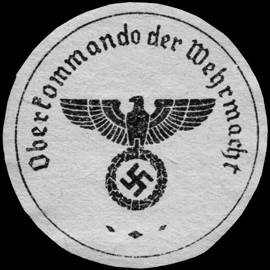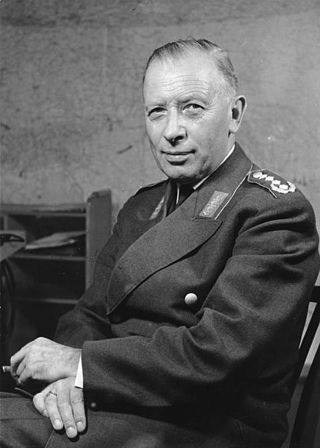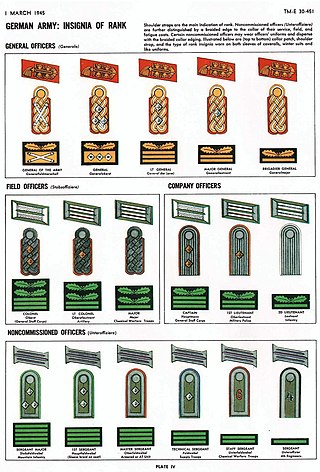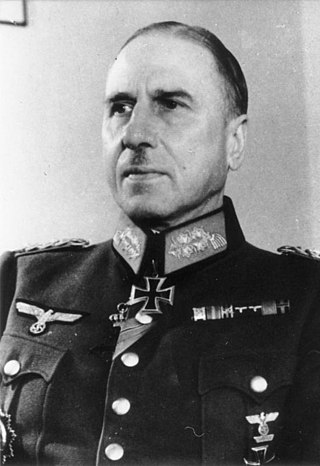
The Oberkommando der Wehrmacht was the high command of the armed forces of Nazi Germany. Created in 1938, the OKW replaced the Reich War Ministry and had oversight over the individual high commands of the country's armed forces: the army, navy, and air force.
Generalfeldmarschall was a rank in the armies of several German states and the Holy Roman Empire (Reichsgeneralfeldmarschall); in the Habsburg monarchy, the Austrian Empire and Austria-Hungary, the rank Feldmarschall was used. The rank was the equivalent to Großadmiral in the Kaiserliche Marine and Kriegsmarine, a five-star rank, comparable to OF-10 in today's NATO naval forces.

Georg Otto Hermann Balck was a highly decorated officer of the German Army who served in both World War I and World War II, rising to the rank of General der Panzertruppe.

A Generaloberst was the second-highest general officer rank in the German Reichswehr and Wehrmacht, the Austro-Hungarian Common Army, the East German National People's Army and in their respective police services. The rank was equal to a four-star full general but below a general field marshal. The rank was equivalent to a Generaladmiral in the Kriegsmarine until 1945 or to a Flottenadmiral in the Volksmarine until 1990. It was the highest ordinary military rank and the highest military rank awarded in peacetime; the higher rank of general field marshal was awarded only in wartime by the head of state. In general, a Generaloberst had the same privileges as a general field marshal.
Gefreiter is a German, Swiss and Austrian military rank that has existed since the 16th century. It is usually the second rank or grade to which an enlisted soldier, airman or sailor could be promoted.

Eduard Wohlrat Christian Dietl was a German general during World War II who commanded the 20th Mountain Army. He received the Knight's Cross of the Iron Cross with Oak Leaves and Swords.

Adolf Bruno Heinrich Ernst Heusinger was a German military officer whose career spanned the German Empire, the Weimar Republic, Nazi Germany and West Germany. He joined the German Army as a volunteer in 1915 and later became a professional soldier. He served as the Operations Chief within the general staff of the High Command of the German Army in the Wehrmacht from 1938 to 1944. He was then appointed acting Chief of the General Staff for two weeks in 1944 following Kurt Zeitzler's resignation. That year, Heusinger was accused of involvement in the 20 July plot to assassinate Adolf Hitler, but was cleared by the People's Court.

Fritz Erich Fellgiebel was a German Army general of signals and resistance fighter in the 20 July plot to assassinate Nazi dictator Adolf Hitler. In 1929, Fellgiebel became head of the cipher bureau of the Ministry of the Reichswehr, which would later become the OKW/Chi. He was a signals specialist and was instrumental in introducing a common enciphering machine, the Enigma machine. However, he was unsuccessful in promoting a single cipher agency to coordinate all operations, as was demanded by OKW/Chi and was still blocked by Joachim von Ribbentrop, Heinrich Himmler and Hermann Göring until autumn 1943. It was not achieved until General Albert Praun took over the post.
General is the highest rank of the German Army and German Air Force. As a four-star rank it is the equivalent to the rank of admiral in the German Navy.

Friedrich Karl Albert Dollmann was a German general during World War II who commanded the 7th Army during the Invasion of France and the early phases of the Allied invasion of Normandy until his death in June 1944.

General der Artillerie may mean:

Otto Dessloch was a German Luftwaffe general during World War II and recipient of the Knight's Cross of the Iron Cross with Oak Leaves of Nazi Germany.

General der Panzertruppe was a General of the branch OF8 rank of the German Army, introduced in 1935. A General der Panzertruppe was a Lieutenant General, above Major General (Generalleutnant), commanding a Panzer corps.

General der Gebirgstruppe was a category of German Army three-star, a new example of the traditional German 'General der' rank introduced by the Wehrmacht in 1940, comparable to the NATO grade OF-8.
Rudolf Konrad was a German general in the Wehrmacht during World War II who served as a corps commander. He was a recipient of the Knight's Cross of the Iron Cross and, by the end of the war, held the rank of General der Gebirgstruppe,.

General of the Cavalry was a General of the branch OF8-rank in the Imperial Army, the interwar Reichswehr, and the Wehrmacht. It was the second-highest General officer rank below Generaloberst. Artillery officers of equivalent rank were called General der Artillerie, and infantry officers of equivalent rank General der Infanterie. The Wehrmacht also created General der Panzertruppen, General der Gebirgstruppen, General der Pioniere (engineers), General der Flieger (aviators), General der Fallschirmtruppen, and General der Nachrichtentruppen

The Heer as the German army and part of the Wehrmacht inherited its uniforms and rank structure from the Reichsheer of the Weimar Republic (1921–1935). There were few alterations and adjustments made as the army grew from a limited peacetime defense force of 100,000 men to a war-fighting force of several million men.

Erick-Oskar Hansen was a German general in the Wehrmacht during World War II. He was a recipient of the Knight's Cross of the Iron Cross of Nazi Germany.
X Army Corps was a corps in the German Army during World War II. It was formed in mid-May 1935 from the Cavalry Division.

Walter Surén was a general officer with the final rank – General der Luftnachrichtentruppe of the Deutsche Luftwaffe in Nazi Germany. Until the end of WW2 in 1945, this particular general officer rank was on three-star level (OF-8), equivalent to a US Lieutenant general.

















